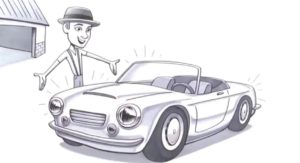You’re traveling down the road at what you think is a safe speed. You seem to be going to same speed as those around you. You look out your window, most of the snow has melted from the storm your town was hit with the night before, but the temperature outside your warm car is still below freezing.
You’re happily driving down the road singing to your favorite band, when all of a sudden you hit a patch of black ice. You never saw it coming. You begin to fishtail and pretty soon your vehicle is spinning like a top across the road and onto the shoulder. Your heart race picks up and adrenaline shoots through your entire body. All you can think of is, “Turn into the slide, turn into the slide.”
While turning into the slide is absolutely what you are supposed to do, there are a few things that you can do to prevent a slide at all as well as a few things you can do to correct yourself if you find yourself in this kind of a situation. These things can help you avoid sliding on icy roads as well as a trip to the collision center.
Reduce Your Speed
Driving at high speeds is one of the worst things you can do when the roads are wet and icy. Never drive over 45 MPH on icy roads-not even on highways. Even driving at less than 10 MPH you can hit black ice and lose control. Remember slowing your speed down can prevent an accident and a trip to the collision center.
Avoid Icy Roads
While your roads may appear dry and not icy, you could be wrong. If you’ve had a storm recently, it is safe to assume your roads have ice on them somewhere. Avoid any unnecessary driving.
Always Wear Your Seatbelt
If you slide on some ice, you could very well be spun into side railings, signs, and cement barriers. This could lead your car being taken into the collision center, but if you wear your seatbelt, you’re less likely to need some repairs yourself.
Avoid Hills and Other Dangerous Roads
Gravity will win this fight if there is ice on the roads. Find alternate routes to your destination, or choose not to go if it isn’t absolutely necessary.
Accidents Happen in Multiples
If one person has hit the ice patch, you can be sure that more will follow. And even if a second vehicle does not lose control on the patch, they might not have time to react to the vehicle in front of them. This can cause people swerving into other lanes and multiple accidents to occur, sending cars to collision centers and people to hospitals.
Turn Into the Slide
If you fishtail or slide, it usually means you were going to fast. Reduce your speed to help avoid either of these. If you do lose control, turn into your slide, it helps your car think this is the direction you are wanting to go. Be sure you don’t turn the wheel to far (overcorrecting), because you’ll want to reduce your speed and gain control of your vehicle again, allowing you to then turn the wheel back the other direction.
Release Your Brakes
Antilock brakes do not work well on ice, and can still lock up your wheels regardless. Remember the best way to avoid a trip to the collision center is to be driving slowly and cautiously.
We hope these tips will help you avoid any trip to the collision center.
Written by: Nicole Weisbrich

